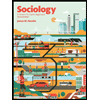SOC Readings Week of 11.19.20
docx
keyboard_arrow_up
School
University of Toronto *
*We aren’t endorsed by this school
Course
SOC100
Subject
Sociology
Date
Jan 9, 2024
Type
docx
Pages
8
Uploaded by CoachPorpoisePerson1058
TEXTBOOK – CHAPTER 14: Social Change: Technology, the Environment, and Social Movements
What is Social Change?
-
Social change refers to the alteration of social structures and cultures
-
Sociological theorists have characterized large-scale social change in three main ways
o
Technology-driven progress
o
A series of responses to environmental challenges
o
The product of large-scale conflict
Technology: Saviour or Frankenstein?
-
Technology is the practical application of scientific principles (to the improvement of human life)
o
Seemed to be driving humanity toward progress, picking up speed as time went on
o
The bombing of Hiroshima divided humanity into two periods, pre-Hiroshima being the era of naïve optimism
-
Technology’s detailed workings rested on scientific principles that were mysterious to the general public
o
People started to have a pessimistic view on technology post-Hiroshima
-
The term normal accident is a term coined by Charles Perrow, meaning an accident that
occurs inevitably although unpredictably because of the complexity of modern technologies
o
A large computer program contains thousands of conditional statements, and when in use, the program activates many billions of combinations of conditional statements
o
As a result, complex programs cannot be tested for all possible eventualities, so when rare combinations of conditions occur, they may have unforeseen consequences that are usually minor, occasionally amusing, sometimes expensive, and too often dangerous
-
Ulrich Beck coined the term risk society
, meaning a society in which technology distributes environmental dangers among all categories of the population, although to varying degrees
o
Danger does not result from technological accidents alone: increased risk is due to mounting environmental threats that are more widespread, chronic, and ambiguous than technological accidents, and therefore more stressful
o
New and frightening terms, such as climate change, global warming, acid rain, ozone depletion, endangered species, have entered our vocabulary
-
To many people, technology seems to be spinning out of control
o
From this POV, it enables the production of more goods/services, but at the cost of air, water, sunlight, plant/animal diversity, and normal weather patterns
-
These raise two questions:
o
Is technology the great driving force of social change?
o
If some people control technology, then exactly who they are they?
Technology and People Cause Social Change
-
Technological determinism is the belief that technology is the main factor shaping human society
o
Technology is definitely a part of this, but is it the main one?
-
Technologies do not become engines of economic growth until social conditions allow them to do so
-
Scientific discoveries, once adopted on a wide scale, often transform societies, but they are turned into useful technologies only when society needs it
How High Tech Became Big Tech
-
Technological advantages often result in big profits for businesses and military superiority for countries
-
In the 19
th
century, it was inexpensive to gain technological advantages, taking only modest capital investment, a little knowledge about the best way to organize work, and some highly trained workers
o
Mass car production, sending people to outer space
-
It was clear by the last quarter of the 19th century that turning scientific principles into technological innovations was going to require not just genius, but also substantial resources, especially money and organization o
E.g. the photograph and the lightbulb
-
As the 20th century progressed more money seemed to be spent on capital investment and on technology -
Economic lures, increasingly provided by the military and big corporations, have generated moral and political qualms among some researchers
Global Warming
-
Global warming Is the gradual worldwide increase in average surface temperatures o
All aspects of the environment are on the rise, including surface air temperature,
water evaporation, more rainfall, etc.
The Social Construction of Environmental Problems
-
Environmental problems do not become social issues spontaneously o
Before they can enter public consciousness, scientists must discover them and promote them -
The controversy over global warming is a good example of how people create and contest definitions of environmental problems o
People question the reliability and legitimacy of the sources and if it actually requires human intervention
-
In the 80s, “bad scientific reporting, bad economics, and bad judgment” is how the Fraser Institute summarized the analysis of those who regarded global warming as a serious issue requiring immediate action o
Because of this statement, public concern about global warming began to falter, even though the evidence toward it was substantial, dangerous, and caused by human activity The Social Distribution of Risk
-
Whenever disaster strikes, economically and politically disadvantage people almost always suffer most, as their circumstances render them the most vulnerable
-
Environmental racism is the tendency to heap environmental dangers on the disadvantage, and especially disadvantaged racial minorities The Canadian Case
-
Environmental racism is evident in Canada o
The uranium used to construct the atom bombs that were dropped on Hiroshima
and Nagasaki came from the Northwest Territories o
Both the American and Canadian governments had known about the dangers of exposure to uranium, yet they withheld this information from the workers, who were completely unprotected from the ore's deadly radiation o
Many workers develop cancer, specifically lung
o
Broadly similar stories of environmental racism are Legion, for instance, a strong correlation exists between the location of black and indigenous communities, and the placement of toxic waste sites The Less Developed Countries
-
What is true in Canada is also true for less developed countries, the underprivileged facing more environmental dangers than the privileged -
Countries such as Mexico, Brazil, China, and India are industrializing rapidly, putting a massive strain on their natural resources o
Because there is a rising demand for these, smog-blanketed megacities continued to sprawl, causing many health issues for those living in them -
On average, people in less developed countries are more concerned about the environment than people in rich counties are -
However, the developing countries cannot afford much in the way of pollution control, so anti-pollution regulations are lax by North American, western European, and Japanese standards -
For the time being, the rich countries do most of the world's environmental damage, as their inhabitants earn and consume much more than the inhabitants of less developed countries consume Market vs. High-Tech Solutions to the Environmental Crisis
-
Some people endorse the theory that the environmental crisis will resolve itself, believing we already have two weapons that will end it: the market and high technology o
Case of oil illustrates how these weapons combine forces. If oil reserves drop or oil is withheld from the market for political reasons, the price of oil will go up. This makes it worthwhile for oil exploration companies to develop new technologies to recover more oil. When they discover more oil and bring it to market, prices fall back to where they were o
Some believe that global warming will be dealt with similarly, human inventiveness in the profit motive will combine to create the new technologies we need to survive and prosper -
However, three factors suggest that market forces and technological fixes cannot solve environmental problems on their own:
1.
Imperfect price signals. The prices of many commodities do not reflect their actual cost to society. In Winnipeg, gasoline costs about $1.02 a litre at the time of this
Your preview ends here
Eager to read complete document? Join bartleby learn and gain access to the full version
- Access to all documents
- Unlimited textbook solutions
- 24/7 expert homework help
writing—inexpensive by world standards because Canadians pay relatively low taxes on gas. However, the social cost of gas, including the cost of repairing the environmental damage caused by burning it, may be three times that amount. Because of such price distortions, the market often fails to send signals that might result in the speedy adoption of technological and policy fixes.
2.
The slow pace of change. Efforts so far to deal with global warming are insufficient; global warming continues to accelerate. One widely respected group of climate scientists and statisticians calculated that if we continue to burn fossil fuels at current rates, then by 2024 it will be exceedingly difficult to avert disaster.
3.
The importance of political pressure. Political pressure exerted by environmental activists, community groups, and public opinion is often necessary to motivate corporate and government action on environmental issues. Without the efforts of such organizations, it is doubtful that many environmental issues would be defined as social problem -
The alternative to the market in high-tech theory is a theory that emphasizes the need for cooperation to greatly reduce overconsumption of just about everything o
This strategy includes investing more heavily in energy saving technologies, doing more to clean up the environment, and subsidizing environmentally friendly industrialization in the developing countries o
It would also require new voluntary efforts new laws and enforcement bodies to ensure compliance, increased Environmental Research, development by industry
and government more environmentally directed foreign aid, and new taxes to help pay for it all Social Movements
-
Governments and corporations are inclined to act on environmental issues only if the public pressures them to do so -
Collective action
occurs when people act in unison to bring about or resist social, political, or economic change o
Under what circumstances do many individuals engage in this?
o
Under what circumstances is this turned into a social movement
, which is a collective attempt to change all or part of a political or social order by means of writing, petitioning, striking, demonstrating, and slash or establishing pressure groups, unions, and political parties?
Breakdown Theory: A Functionalist Account
-
Until about 1970, most sociologists believe that two conditions must be met for social movements to form:
1.
Social marginality. The early leaders of social movements and their first recruits must be poorly integrated into society. Without such socially marginal people, social movements supposedly cannot form.
2.
Strain. People’ s norms must be strained or disrupted. For example, one of the most popular variants of breakdown theory is relative deprivation theory. Relative deprivation theory refers to an intolerable gap between the social rewards people receive and the social rewards they expect to achieve. Supposedly, people are most
likely to form social movements when the gap between rising expectations and the receipt of social rewards becomes intolerable.
-
We can group these two conditions together as the breakdown theory
, which suggests that social movements emerge when traditional norms and patterns of social organization are disrupted o
This can be seen as a variant of functionalism because it regards collective action
as a form of social imbalance that results from the improper functioning of social
institutions -
Breakdown theory cannot adequately account for the crystallization of social movements because of two main flaws:
o
Research shows that in most cases, leaders and early joiners of social movements are well integrated members of their community, not socially marginal outsiders o
Researchers have found that high levels of relative deprivation are generally not associated with the crystallization of social movements because certain social conditions can prevent people from translating their discontent into an enduring social movement with more or less stable membership, hired office personnel, a publicity Bureau, a regularly published newsletter, and the like
Solidarity Theory: A Conflict Approach
-
Solidarity theory holds that social movements are social organizations that emerge when potential members can mobilize resources, take advantage of new political opportunities, and avoid high levels of social control by authorities
Resource Mobilization
-
Most collective action is part of a power struggle; the struggle usually intensifies as groups whose members feel disadvantage become more powerful relative to other groups -
Resource mobilization
is the process by which social movements crystallized because of the increasing organizational, material, and other resources of movement members -
Consider the effect of resource mobilization on the frequency of strikes in Canada.
o
Research shows that in Canada between the 1940s and the 1970s, strike frequency was high when
Unemployment was low
Union membership was high
Governments were generous in their provision of social welfare benefits Political Opportunities
-
Political opportunities are chances for collective action and social movement growth that occur during election campaigns, when influential allies offer support to insurgents, when ruling political alignments become unstable, and when elite groups become divided and conflict with one another -
Collective action takes place in social movements crystallized not just one disadvantage groups become more powerful but also unprivileged groups in the institutions they control are divided and therefore become weaker Social Control
-
Government reactions to protest influence subsequent protests
-
Specifically, governments can try to lower the frequency and intensity of protests by taking various social control measures o
These measures include making concessions to protesters, coopting the most troublesome leaders, and violently repressing collective action -
However, social control measures do not always have the desired effect o
E.g. government concessions may encourage protesters to press their claims further Framing Theory: The Contribution of Symbolic Interactionism
-
It seems that something lies between the capacity of Disadvantaged people to mobilize resources for collective action and the recruitment of a substantial number of movement members -
That something is frame alignment
, which is the process by which individual interests, beliefs, and values become congruent and complementary with the activities, goals, and
ideology of a social movement Types of Frame Alignment
o
Social movement leaders can reach out to other organizations that, they believe,
include people who may be sympathetic to their movements cause o
Movement activists can stress popular values that have so far not featured prominently in the thinking of potential recruits. They can also elevate the importance of positive beliefs about the movement and what it stands for o
Social movements can stretch their objectives and activities to win recruits who were not initially sympathetic to the movement's original aims -
While movements seek to align their goals, ideas, and activities with the way potential recruits frame issues, their adversaries seek to disalign the way issues are framed by movements and potential recruits New Social Movements
Goals
-
Some new social movements promote the rights not of specific groups but of humanity as a whole to peace, security, and a clean environment o
Since the 60s, the women's movement has succeeded in getting admission practices altered in professional schools, placing women on an equal footing with men. It has also one more freedom of reproductive choice for women and opened up opportunities for women in the political, religious, military, educational, medical, legal, and business systems. To a degree, the women's movement has also helped altered the division of domestic labour, with many men now taking on a larger share of household work, including childcare, than that was the case in the past o
Also originating in the 1960s, the gay rights movement has achieved significant law reform involving the repeal of discriminatory legislation such as anti-sodomy laws and laws that have negatively affected parental custody of children. It has also fought and succeeded in two dozen countries for marriage equality.
o
Disproportionate police violence is routinely visited on the black community throughout North America. In 2013, the Black Lives Matter movement emerged
Your preview ends here
Eager to read complete document? Join bartleby learn and gain access to the full version
- Access to all documents
- Unlimited textbook solutions
- 24/7 expert homework help
to publicize and express outrage over such, in hope of achieving less discriminatory police practice
o
The Idle No More movement was founded by three Indigenous Canadian women
and a non-Indigenous supporter in 2012. Largely coordinated through social media, its members have blockaded railways, organized public round dances, and held demonstrations to promote land claims, Environmental Protection, and other issues of particular concern to Canada's Indigenous peoples o
The MeToo movement seeks to publicize the magnitude of the problem of sexual
harassment, publicly shame individuals who sexually harass others, and kindle a cultural change in norms surrounding the problem. There has been widespread support of this movement by celebrities
Membership
-
New social movements are also novel in that they attract a disproportionately large number of highly educated, relatively well-to-do people from the social, educational, and cultural fields
o
Some people include teachers, professors, journalists, social workers, artists, actors, writers, and student apprentices o
These people's higher education exposes them to radical ideas and makes those ideas appealing Globalization Potential
-
New social movements increase the scope of protests beyond the national level -
Inexpensive international travel and communication facilitate the globalization of social movements -
New technologies make it easier for people in various national movements to work with like-minded activists in other countries END OF CHAPTER QUIZ
1. A new group of major inventions has cropped up every 40 to 60 years since the Industrial Revolution. These flurries of creativity cause major economic growth spurts, beginning 10 to 20 years later and lasting 25 to 35 years each. What term describes this phenomenon? a. Sutton’s law b. Kondratiev waves c. social constructionism
d. technological indeterminism
2. More than two million used uranium fuel bundles are sitting at temporary storage sites in Canada. Their useful life fuelling nuclear reactors is over. Scientists and government officials know that they will be dangerously radioactive for at least another 10 000 years and that leakage could cause mass radioactive poisoning to nearby populations. Does this constitute a social problem? a. Yes. If the authorities know about the situation and many people are in harm’s way, it
is a big social problem.
b. No. However, the situation could become a social problem if a social movement and the mass media publicize it and many people come to recognize that the situation could harm them.
c. Maybe. The information provided is too vague to permit one to decide whether the situation constitutes a social problem or not.
d. Probably. Governments can’t keep secrets; there are always leaks.
3. An intolerable gap develops between the social rewards people expect to receive and those they actually receive. What do they experience? a. strain b. social marginality
c. resource mobilization d. relative deprivation
4. Social movement leaders decide to water down their movement’s ideals because they think that would enable them to recruit more members. What activity are they engaged in? a. frame alignment b. co-optation c. resource mobilization d. social control
5. What does survey research conducted in Egypt during the Arab Spring show? a. Using new electronic communications media was associated with being a protester.
b. Protesters tended to be people with strong grievances related to unemployment, poverty, and corruption.
c. Protesters were more available for protest activities than others were because they tended to be unmarried men living in cities and tended to have strong, pre-existing ties to various charitable, political, and other civic associations.
d. all of the above
Related Documents
Recommended textbooks for you

Social Psychology (10th Edition)
Sociology
ISBN:9780134641287
Author:Elliot Aronson, Timothy D. Wilson, Robin M. Akert, Samuel R. Sommers
Publisher:Pearson College Div

Introduction to Sociology (Eleventh Edition)
Sociology
ISBN:9780393639407
Author:Deborah Carr, Anthony Giddens, Mitchell Duneier, Richard P. Appelbaum
Publisher:W. W. Norton & Company

The Basics of Social Research (MindTap Course Lis...
Sociology
ISBN:9781305503076
Author:Earl R. Babbie
Publisher:Cengage Learning

Criminalistics: An Introduction to Forensic Scien...
Sociology
ISBN:9780134477596
Author:Saferstein, Richard
Publisher:PEARSON

Sociology: A Down-to-Earth Approach (13th Edition)
Sociology
ISBN:9780134205571
Author:James M. Henslin
Publisher:PEARSON

Society: The Basics (14th Edition)
Sociology
ISBN:9780134206325
Author:John J. Macionis
Publisher:PEARSON
Recommended textbooks for you
 Social Psychology (10th Edition)SociologyISBN:9780134641287Author:Elliot Aronson, Timothy D. Wilson, Robin M. Akert, Samuel R. SommersPublisher:Pearson College Div
Social Psychology (10th Edition)SociologyISBN:9780134641287Author:Elliot Aronson, Timothy D. Wilson, Robin M. Akert, Samuel R. SommersPublisher:Pearson College Div Introduction to Sociology (Eleventh Edition)SociologyISBN:9780393639407Author:Deborah Carr, Anthony Giddens, Mitchell Duneier, Richard P. AppelbaumPublisher:W. W. Norton & Company
Introduction to Sociology (Eleventh Edition)SociologyISBN:9780393639407Author:Deborah Carr, Anthony Giddens, Mitchell Duneier, Richard P. AppelbaumPublisher:W. W. Norton & Company The Basics of Social Research (MindTap Course Lis...SociologyISBN:9781305503076Author:Earl R. BabbiePublisher:Cengage Learning
The Basics of Social Research (MindTap Course Lis...SociologyISBN:9781305503076Author:Earl R. BabbiePublisher:Cengage Learning Criminalistics: An Introduction to Forensic Scien...SociologyISBN:9780134477596Author:Saferstein, RichardPublisher:PEARSON
Criminalistics: An Introduction to Forensic Scien...SociologyISBN:9780134477596Author:Saferstein, RichardPublisher:PEARSON Sociology: A Down-to-Earth Approach (13th Edition)SociologyISBN:9780134205571Author:James M. HenslinPublisher:PEARSON
Sociology: A Down-to-Earth Approach (13th Edition)SociologyISBN:9780134205571Author:James M. HenslinPublisher:PEARSON Society: The Basics (14th Edition)SociologyISBN:9780134206325Author:John J. MacionisPublisher:PEARSON
Society: The Basics (14th Edition)SociologyISBN:9780134206325Author:John J. MacionisPublisher:PEARSON

Social Psychology (10th Edition)
Sociology
ISBN:9780134641287
Author:Elliot Aronson, Timothy D. Wilson, Robin M. Akert, Samuel R. Sommers
Publisher:Pearson College Div

Introduction to Sociology (Eleventh Edition)
Sociology
ISBN:9780393639407
Author:Deborah Carr, Anthony Giddens, Mitchell Duneier, Richard P. Appelbaum
Publisher:W. W. Norton & Company

The Basics of Social Research (MindTap Course Lis...
Sociology
ISBN:9781305503076
Author:Earl R. Babbie
Publisher:Cengage Learning

Criminalistics: An Introduction to Forensic Scien...
Sociology
ISBN:9780134477596
Author:Saferstein, Richard
Publisher:PEARSON

Sociology: A Down-to-Earth Approach (13th Edition)
Sociology
ISBN:9780134205571
Author:James M. Henslin
Publisher:PEARSON

Society: The Basics (14th Edition)
Sociology
ISBN:9780134206325
Author:John J. Macionis
Publisher:PEARSON